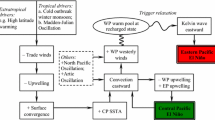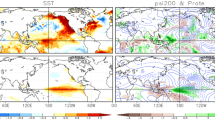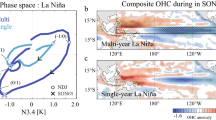Abstract
Statistically different precursory air–sea signals between a super and a regular El Niño group are investigated, using observed SST and rainfall data, and oceanic and atmospheric reanalysis data. The El Niño events during 1958–2008 are first separated into two groups: a super El Niño group (S-group) and a regular El Niño group (R-group). Composite analysis shows that a significantly larger SST anomaly (SSTA) tendency appears in S-group than in R-group during the onset phase [April–May(0)], when the positive SSTA is very small. A mixed-layer heat budget analysis indicates that the tendency difference arises primarily from the difference in zonal advective feedback and the associated zonal current anomaly (u′). This is attributed to the difference in the thermocline depth anomaly (D′) over the off-equatorial western Pacific prior to the onset phase, as revealed by three ocean assimilation products. Such a difference in D′ is caused by the difference in the wind stress curl anomaly in situ, which is mainly regulated by the anomalous SST and precipitation over the Maritime Continent and equatorial Pacific.
Similar content being viewed by others
References
Balmaseda, M. A., K. Mogensen, and A. T. Weaver, 2013: Evaluation of the ECMWF ocean reanalysis system ORAS4. Quart. J. Roy. Meteor. Soc., 139, 1132–1161.
Carton, J. A., and B. S. Giese, 2008: A Reanalysis of ocean climate using simple ocean data assimilation (SODA). Mon. Wea. Rev., 136, 2999–3017.
Chao, J. P., and R. H. Zhang, 1990: The air-sea interaction waves in the tropics and their instabilities. Acta Meteorologica Sinica, 48, 46–54. (in Chinese)
Chen, D. K., and Coauthors, 2015a: Strong influence of westerly wind bursts on El Niño diversity. Nature Geosci., 8, 339–345.
Chen, L., T. Li, and Y. Q. Yu, 2015b: Causes of strengthening and weakening of ENSO amplitude under global warming in four CMIP5 models. J. Climate, 28, 3250–3274.
Chen, L., Y. Q. Yu, and W.-P. Zheng, 2016: Improved ENSO simulation from climate system model FGOALS-g1.0 to FGOALS-g2, Climate Dyn., 1–18, doi: 10.1007/s00382-016-2988-8.
Chen, M. Y., P. P. Xie, J. E. Janowiak, and P. A. Arkin, 2002: Global land precipitation: A 50-yr monthly analysis based on gauge observations. J. Hydrometeor., 3, 249–266.
Clarke, A. J., 2010: Analytical theory for the quasi-steady and lowfrequency equatorial ocean response to wind forcing: The “tilt” and “warm water volume” modes. J. Phys. Oceanogr., 40, 121–137.
Ding, R. Q., J. P. Li, and Y.-H. Tseng, 2015: The impact of South Pacific extratropical forcing on ENSO and comparisons with the North Pacific. Climate Dyn., 44, 2017–2034.
Eisenman, I., L. Yu, and E. Tziperman, 2005: Westerly wind bursts: ENSO’s tail rather than the dog? J. Climate, 18, 5224–5238.
Fedorov, A. V., S. N. Hu, M. Lengaigne, and E. Guilyardi, 2015: The impact of westerly wind bursts and ocean initial state on the development, and diversity of El Niño events. Climate Dyn., 44, 1381–1401.
Gebbie, G., I. Eisenman, A. Wittenberg, and E. Tziperman, 2007: Modulation of westerly wind bursts by sea surface temperature: a semistochastic feedback for ENSO. J. Atmos. Sci., 64, 3281–3295.
Gill, A. E., 1980: Some simple solutions for heat-induced tropical circulation. Quart. J. Roy. Meteor. Soc., 106, 447–462.
Hirst, A. C., 1988: Slow instabilities in tropical ocean basin-global atmosphere models. J. Atmos. Sci., 45, 830–852.
Hong, L. C., Lin Ho, and F. F. Jin, 2014: A southern hemisphere booster of super El Niño. Geophys. Res. Lett., 41, 2142–2149.
Hu, S.-N., and A. V. Fedorov, 2016: Exceptionally strong easterly wind burst stalling El Niño of 2014. Proc. Natl. Acad. Sci. U. S. A., 113, 2005–2010.
Hu, S.-N., A. V. Fedorov, M. Lengaigne, and E. Guilyardi, 2014: The impact of westerly wind bursts on the diversity and predictability of El Niño events: an ocean energetics perspective. Geophys. Res. Lett., 41, 4654–4663, doi: 10.1002/2014 GL059573.
Huang, B.-Y., Y. Xue, D. X. Zhang, A. Kumar, and M. J. McPhaden, 2010: The NCEP GODAS ocean analysis of the tropical pacific mixed layer heat budget on seasonal to interannual time scales. J. Climate, 23, 4901–4925.
Huang, R. H., and Y. F. Wu, 1989: The influence of ENSO on the summer climate change in China and its mechanism. Adv. Atmos. Sci., 6, 21–32, doi: 10.1007/BF02656915.
Huffman, G. J., R. F. Adler, D. T. Bolvin, and G. J. Gu, 2009: Improving the global precipitation record: GPCP version 2.1. Geophys. Res. Lett., 36, L17808.
Jin, F. F., S. I. An, A. Timmermann, and J. X. Zhao, 2003: Strong El Niño events and nonlinear dynamical heating. Geophys. Res. Lett., 30(3), 1120, doi: 10.1029/2002GL016356.
Jin, F. F., L. Lin, A. Timmermann, and J. Zhao, 2007: Ensemblemean dynamics of the ENSO recharge oscillator under state-dependent stochastic forcing. Geophys. Res. Lett., 34, L03807, doi: 10.1029/2006GL027372.
Kalnay, E., and Coauthors, 1996: The NCEP/NCAR 40-year reanalysis project. Bull. Am. Meteor. Soc., 77, 437–471.
Kessler, W. S., 2006: The circulation of the eastern tropical Pacific: A review. Progr. Oceanogr., 69, 181–217.
Kumar, A., and Z. Z. Hu, 2012: Uncertainty in the oceanatmosphere feedbacks associated with ENSO in the reanalysis products. Climate Dyn., 39, 575–588.
Kumar, A., and Z.-Z. Hu, 2014: Interannual and interdecadal variability of ocean temperature along the equatorial Pacific in conjunction with ENSO. Climate Dyn., 42, 1243–1258.
Latif, M., V. A. Semenov, and W. Park, 2015: Super El Niños in response to global warming in a climate model. Climatic Change, 132, 489–500.
Lengaigne, M., E. Guilyardi, J. P. Boulanger, C. Menkes, P. Delecluse, P. Inness, J. Cole, and J. Slingo, 2004: Triggering of El Niño by westerly wind events in a coupled general circulation model. Climate Dyn., 23, 601–620.
Levine, A. F., and F.-F. Jin, 2010: Noise-induced instability in the ENSO recharge oscillator. J. Atmos. Sci., 67, 529–542.
Li, C. Y., 1990: Interaction between anomalous winter monsoon in East Asia and El Niño events. Adv. Atmos. Sci., 7, 36–46, doi: 10.1007/BF02919166
Li, J. Y., B. Q. Liu, J. D. Li, and J. Y. Mao, 2015: A comparative study on the dominant factors responsible for the weakerthan- expected El Niño event in 2014. Adv. Atmos. Sci., 32, 1381–1390, doi: 10.1007/s00376-015-4269-6.
Li, T., 1997: Phase transition of the El Niño-southern oscillation: A stationary SST mode. J. Atmos. Sci., 54, 2872–2887.
Li, T., Y. S. Zhang, E. Lu, and D. L. Wang, 2002: Relative role of dynamic and thermodynamic processes in the development of the Indian Ocean dipole: An OGCM diagnosis. Geophys. Res. Lett., 29, 25-1–25-4.
McPhaden, M. J., 1999: Genesis and evolution of the 1997-98 El Niño. Science, 283, 950–954.
Menkes, C. E., M. Lengaigne, J. Vialard, M. Puy, P. Marchesiello, S. Cravatte, and G. Cambon, 2014: About the role of westerly wind events in the possible development of an El Niño in 2014. Geophys. Res. Lett., 41, 6476–6483.
Min, Q. Y., J. Z. Su, R. H. Zhang, and X. Y. Rong, 2015: What hindered the El Niño pattern in 2014? Geophys. Res. Lett., 42, 6762–6770, doi: 10.1002/2015GL064899.
Philander, S. G. H., T. Yamagata, and R. C. Pacanowski, 1984: Unstable air-sea interactions in the tropics. J. Atmos. Sci., 41, 604–613.
Ramesh, N., and R. Murtugudde, 2013: All flavours of El Niño have similar early subsurface origins. Nature Clim. Change, 3, 42–46.
Rong, X. Y., R. H. Zhang, T. Li, and J. Z. Su, 2011: Upscale feedback of high-frequency winds to ENSO. Quart. J. Roy. Meteor. Soc., 137, 894–907.
Russell, D. R., 2006: Development of a time-domain, variableperiod surface-wave magnitude measurement procedure for application at regional and teleseismic distances, Part I: Theory. Bull. Seismol. Soc. Am., 96, 665–677.
Saha, S., and Coauthors, 2006: The NCEP climate forecast system. J. Climate, 19, 3483–3517.
Smith, T. M., R. W. Reynolds, T. C. Peterson, and J. Lawrimore, 2008: Improvements to NOAA’s historical merged land-ocean surface temperature analysis (1880–2006). J. Climate, 21, 2283–2296.
Su, J. Z., R. H. Zhang, T. Li, X. Y. Rong, J. S. Kug, and C.-C. Hong, 2010: Causes of the El Niño and La Niña amplitude asymmetry in the equatorial eastern Pacific. J. Climate, 23, 605–617.
Su, J. Z., B. Q. Xiang, B. Wang, and T. Li, 2014: Abrupt termination of the 2012 Pacific warming and its implication on ENSO prediction. Geophys. Res. Lett., 41, 9058–9064.
Takahashi, K., and B. Dewitte, 2016: Strong and moderate nonlinear El Niño regimes. Climate Dyn., 46, 1627–1645, doi: 10.1007/s00382-015-2665-3.
Timmermann, A., F.-F. Jin, and J. Abschagen, 2003: A nonlinear theory for El Niño bursting. J. Atmos. Sci., 60, 152–165.
Tollefson, J., 2014: El Niño tests forecasters. Nature, 508, 20–21.
Vecchi, G. A., and D. E. Harrison, 2006: The termination of the 1997-98 El Niño. Part I: Mechanisms of oceanic change. J. Climate, 19, 2633–2646.
Wang, B., and T. M. Li, 1993: A simple tropical atmosphere model of relevance to short-term climate variations. J. Atmos. Sci., 50, 260–284.
Wang, L., T. Li, and T. J. Zhou, 2012: Intraseasonal SST variability and air-sea interaction over the Kuroshio extension region during boreal summer. J. Climate, 25, 1619–1634.
Wyrtki, K., 1975: El Niño-the dynamic response of the equatorial Pacific Ocean to atmospheric forcing. J. Phys. Oceanogr., 5, 572–584.
Wyrtki, K., 1985: Water displacements in the Pacific and the genesis of El Niño cycles. J. Geophys. Res.: Oceans, 90, 7129–7132.
Xie, P. P., and P. A. Arkin, 1997: Global precipitation: A 17-year monthly analysis based on gauge observations, satellite estimates, and numerical model outputs. Bull. Am. Meteor. Soc., 78, 2539–2558.
Yu, L., X. Jin, and R. A. Weller, 2008: Multidecade global flux datasets from the objectively analyzed air-sea fluxes (OAFlux) project: Latent and sensible heat fluxes, ocean evaporation, and related surface meteorological variables. OAFlux Project Technical Report OA-2008-01, 64 pp.
Yu, Y., and D.-Z. Sun, 2009: Response of ENSO and the mean state of the tropical Pacific to extratropical cooling and warming: A study using the IAP coupled model. J. Climate, 22, 5902–5917.
Zebiak, S. E., and M. A. Cane, 1987: A model El Niño-southern oscillation. Mon. Wea. Rev., 115, 2262–2278.
Zhang, Y. C., W. B. Rossow, A. A. Lacis, V. Oinas, and M. I. Mishchenko, 2004: Calculation of radiative fluxes from the surface to top of atmosphere based on ISCCP and other global data sets: Refinements of the radiative transfer model and the input data. J. Geophys. Res., 109, D19105, doi: 10.1029/2003 JD004457.
Zheng, F., L. H. Feng, and J. Zhu, 2015: An incursion of offequatorial subsurface cold water and its role in triggering the “double dip” La Niña event of 2011. Adv. Atmos. Sci., 32, 731–742, doi: 10.1007/s00376-014-4080-9.
Author information
Authors and Affiliations
Corresponding author
Electronic supplementary material
Rights and permissions
About this article
Cite this article
Chen, L., Li, T., Behera, S.K. et al. Distinctive precursory air–sea signals between regular and super El Niños. Adv. Atmos. Sci. 33, 996–1004 (2016). https://doi.org/10.1007/s00376-016-5250-8
Received:
Revised:
Accepted:
Published:
Issue Date:
DOI: https://doi.org/10.1007/s00376-016-5250-8




